Performance of Damage Identification Based on Directional Wavelet Transforms and Entopic Weights Using Experimental Shearographic Testing Results
Abstract
1. Introduction
2. Theoretical Background and Proposed Damage Identification Algorithm
2.1. Directional Wavelet Transforms
2.2. Wavelet Entropy
2.3. Damage Identification Algorithm
3. Materials, Testing Procedure and Data Pre-Processing
4. Analysis of Performance of Damage Identification Algorithms
4.1. Algorithm Based on DWT
4.2. Algorithm Based on DTWT
4.3. Algorithm Based on DDWT
4.4. Algorithm Based on DTDDWT
4.5. Performance Evaluation and Discussion
5. Conclusions
Funding
Institutional Review Board Statement
Data Availability Statement
Acknowledgments
Conflicts of Interest
References
- Fan, W.; Qiao, P. Vibration-based damage identification methods: A review and comparative study. Struct. Health Monit. 2011, 10, 83–129. [Google Scholar] [CrossRef]
- Ratcliffe, C.; Heider, D.; Crane, R.; Krauthauser, C.; Yoon, M.K.; Gillespie, J.W., Jr. Investigation into the use of low cost MEMS accelerometers for vibration based damage detection. Compos. Struct. 2008, 82, 61–70. [Google Scholar] [CrossRef]
- Domaneschi, M.; Limongelli, M.P.; Martinelli, L. Vibration based damage localization using MEMS on a suspension bridge model. Smart Struct. Syst. 2013, 12, 679–694. [Google Scholar] [CrossRef]
- Dos Santos, F.L.M.; Peeters, B.; Van der Auveraer, H.; Góes, L.C.S.; Desmet, W. Vibration-based damage detection for a composite helicopter main rotor blade. Case Stud. Mech. Syst. Signal Process. 2016, 3, 22–27. [Google Scholar] [CrossRef]
- Avci, O.; Abdeljaber, O.; Kiranyaz, S.; Hussein, M.; Gabbouj, M.; Inman, D.J. A review of vibration-based damage detection in civil structures: From traditional methods to Machine Learning and Deep Learning applications. Mech. Syst. Signal Process. 2021, 147, 107077. [Google Scholar] [CrossRef]
- Fan, W.; Qiao, P. A 2-D continuous wavelet transform of mode shape data for damage detection of plate structures. Int. J. Solids Struct. 2009, 46, 4379–4395. [Google Scholar] [CrossRef]
- Yang, C.; Fu, Y.; Yuan, J.; Guo, M.; Yan, K.; Liu, H.; Miao, H.; Zhu, C. Damage identification by using a self-synchronizing multipoint laser Doppler vibrometer. Shock Vib. 2015, 2015, 476054. [Google Scholar] [CrossRef]
- Katunin, A.; Wronkowicz, A. Influence of parameters of modal analysis on vibration-based structural damage detectability. J. Vibroeng. 2015, 17, 4153–4163. [Google Scholar]
- Lopes, H.M.R.; Araújo dos Santos, J.V.; Mota Soares, C.M.; Miranda Guedes, R.J.; Pires Vaz, M.A. A numerical-experimental method for damage location based on rotation fields spatial differentiation. Comput. Struct. 2011, 89, 1754–1770. [Google Scholar] [CrossRef]
- Araújo dos Santos, J.V.; Lopes, H. Damage localization based on modal response measured with shearography. In Vibration-Based Techniques for Damage Detection and Localization in Engineering Structures; Nobari, A.S., Ferri Aliabadi, M.H., Eds.; World Scientific: Singapore, 2018; Volume 10, pp. 141–172. [Google Scholar]
- Hung, Y.Y. Shearography for non-destructive evaluation of composite structures. Opt. Laser. Eng. 1996, 24, 161–182. [Google Scholar] [CrossRef]
- Hung, Y.Y.; Chen, Y.S.; Ng, S.P.; Liu, L.; Huang, Y.H.; Luk, B.L.; Ip, R.W.L.; Wu, C.M.L.; Chung, P.S. Review and comparison of shearography and active thermography for nondestructive evaluation. Mater. Sci. Eng. R Rep. 2009, 64, 73–112. [Google Scholar] [CrossRef]
- Francis, D.; Tatam, R.P.; Groves, R.M. Shearography technology and applications: A review. Meas. Sci. Technol. 2010, 21, 102001. [Google Scholar] [CrossRef]
- Douka, E.; Loutridis, S.; Trochidis, A. Crack identification in plates using wavelet analysis. J. Sound Vib. 2004, 270, 279–295. [Google Scholar] [CrossRef]
- Loutridis, S.; Douka, E.; Hadjileontiadis, L.J.; Trochidis, A. A two-dimensional wavelet transform for detection of cracks in plates. Eng. Struct. 2005, 27, 1327–1338. [Google Scholar] [CrossRef]
- Rucka, M.; Wilde, K. Application of continuous wavelet transform in vibration based damage detection method for beams and plates. J. Sound Vib. 2006, 297, 536–550. [Google Scholar] [CrossRef]
- Bayissa, W.L.; Haritos, N.; Thelandersson, S. Vibration-based structural damage identification using wavelet transform. Mech. Syst. Signal Process. 2008, 22, 1194–1215. [Google Scholar] [CrossRef]
- Huang, Y.; Meyer, D.; Nemat-Nasser, S. Damage detection with spatially distributed 2D Continuous Wavelet Transform. Mech. Mater. 2009, 41, 1096–1107. [Google Scholar] [CrossRef]
- Bagheri, A.; Ghodrati Amiri, G.; Khorasani, M.; Bakhshi, A. Structural damage identification of plates based on modal data using 2D discrete wavelet transform. Struct. Eng. Mech. 2011, 40, 13–28. [Google Scholar] [CrossRef]
- Katunin, A. Damage identification in composite plates using two-dimensional B-spline wavelets. Mech. Syst. Signal Process. 2011, 25, 3153–3167. [Google Scholar] [CrossRef]
- Masoumi, M.; Reza Ashory, M. Damage identification in plate-type structures using 2-D spatial wavelet transform and flexibility-based methods. Int. J. Fract. 2013, 183, 259–266. [Google Scholar] [CrossRef]
- Zhou, J.; Li, Z.; Chen, J. Damage identification method based on continuous wavelet transform and mode shapes for composite laminates with cutouts. Compos. Struct. 2018, 191, 12–23. [Google Scholar] [CrossRef]
- Abdulkareem, M.; Bahkary, N.; Vafaei, M.; Md Noor, N.; Noor Mohamed, R. Application of two-dimensional wavelet transform to detect damage in steel plate structures. Measurement 2019, 146, 912–923. [Google Scholar] [CrossRef]
- Xu, W.; Radzieński, M.; Ostachowicz, W.; Cao, M. Damage detection in plates using two-dimensional directional Gaussian wavelets and laser scanned operating deflection shapes. Struct. Health Monit. 2013, 12, 457–468. [Google Scholar] [CrossRef]
- Cao, M.-S.; Xu, W.; Ren, W.-X.; Ostachowicz, W.; Sha, G.-G.; Pan, L.-X. A concept of complex-wavelet modal curvature for detecting multiple cracks in beams under noisy conditions. Mech. Syst. Signal Process. 2016, 76–77, 555–575. [Google Scholar] [CrossRef]
- Bagheri, A.; Ghodrati Amiri, G.; Seyed Razaghi, S.A. Vibration-based damage identification of plate structures via curvelet transform. J. Sound Vib. 2009, 327, 593–603. [Google Scholar] [CrossRef]
- Nicknam, A.; Hosseini, M.H.; Bagheri, A. Damage detection and denoising in two-dimensional structures using curvelet transform by wrapping method. Arch. Appl. Mech. 2011, 81, 1915–1924. [Google Scholar] [CrossRef]
- Katunin, A.; Przystałka, P. Damage assessment in composite plates using fractional wavelet transform of modal shapes with optimized selection of spatial wavelets. Eng. Appl. Artif. Intel. 2014, 30, 73–85. [Google Scholar] [CrossRef]
- Katunin, A. Identification of stiff inclusion in circular composite plate based on quaternion wavelet analysis of modal shapes. J. Vibroeng. 2014, 16, 2545–2551. [Google Scholar]
- Katunin, A.; Przystałka, P. Automated wavelet-based damage identification in sandwich structures using modal curvatures. J. Vibroeng. 2015, 17, 2977–2986. [Google Scholar]
- Kingsbury, N. Image processing with complex wavelets. Phil. Trans. R. Soc. Lond. A 1999, 357, 2543–2560. [Google Scholar] [CrossRef]
- Kingsbury, N. Complex wavelets for shift invariant analysis and filtering of signals. Appl. Comput. Harm. Anal. 2001, 10, 234–253. [Google Scholar] [CrossRef]
- Selesnick, I. The double density DWT. In Wavelets in Signal and Image Analysis: From Theory to Practice; Petrosian, A.A., Meyer, F.G., Eds.; Kluwer Academic Publishers: Norwell, MA, USA, 2001; pp. 39–66. [Google Scholar]
- Selesnick, I.W. A new complex-directional wavelet transform and its application to image denoising. In Proceedings of the International Conference on Image Processing, Rochester, NY, USA, 22–25 September 2002; IEEE: Rochester, NY, USA, 2002; pp. 573–576. [Google Scholar]
- Selesnick, I.W. The double-density dual-tree DWT. IEEE Trans. Signal Proc. 2004, 52, 1304–1314. [Google Scholar] [CrossRef]
- Selesnick, I.W.; Baraniuk, R.G.; Kingsbury, N.G. The dual-tree complex wavelet tranasform. IEEE Signal Proc. Mag. 2005, 22, 123–151. [Google Scholar] [CrossRef]
- Zhang, Z.; Ma, S.; Liu, H.; Gong, Y. An edge detection approach based on directional wavelet transform. Comput. Math. Appl. 2009, 57, 1265–1271. [Google Scholar] [CrossRef]
- Li, J.; Gong, W.; Li, W.; Liu, X. Robust pedestrian detection in thermal infrared imagery using the wavelet transform. Infrared Phys. Technol. 2010, 53, 267–273. [Google Scholar] [CrossRef]
- Lo, E.H.S.; Pickering, M.R.; Frater, M.R.; Arnold, J.F. Image segmentation from scale and rotation invariant texture features from the double dyadic dual-tree complex wavelet transform. Image Vis. Comput. 2011, 29, 15–28. [Google Scholar] [CrossRef]
- Rahulkar, A.D.; Holambe, R.S. Partial iris feature extraction and recognition based on a new combined directional and rotated directional wavelet filter banks. Neurocomputing 2012, 81, 12–23. [Google Scholar] [CrossRef]
- Chakraborty, S.; Bhattacharya, I.; Chatterjee, A. A palmprint based biometric authentication system using dual tree complex wavelet transform. Measurement 2013, 46, 4179–4188. [Google Scholar] [CrossRef]
- Yang, Y.; Tong, S.; Huang, S.; Lin, P. Dual-tree complex wavelet transform and image block residual-based multi-focus image fusion in visual sensor networks. Sensors 2014, 14, 22408–22430. [Google Scholar] [CrossRef]
- Das, A.B.; Bhuiyan, M.I.H.; Shafiul Alam, S.M. Classification of EEG signals using normal inverse Gaussian parameters in the dual-tree complex wavelet transform domain for seizure detection. Signal Image Video Process. 2016, 10, 259–266. [Google Scholar] [CrossRef]
- Wang, Y.; He, Z.; Zi, Y. Enhancement of signal denoising and multiple fault signatures detecting in rotating machinery using dual-tree complex wavelet transform. Mech. Syst. Signal Process. 2010, 24, 119–137. [Google Scholar] [CrossRef]
- Seshadrinath, J.; Singh, B.; Panigrahi, B.K. Vibration analysis based interturn fault diagnosis in induction machines. IEEE Trans. Ind. Inform. 2014, 10, 340–350. [Google Scholar] [CrossRef]
- Hu, B.; Li, B. A new multiscale noise tuning stochastic resonance for enhanced fault diagnosis in wind turbine drivetrains. Meas. Sci. Technol. 2016, 27, 025017. [Google Scholar] [CrossRef]
- Chen, X.; Cheng, G.; Li, H.; Li, Y. Fault identification method for planetary gear based on DT-CWT threshold denoising and LE. J. Mech. Sci. Technol. 2017, 31, 1035–1047. [Google Scholar] [CrossRef]
- Xiao, Y.; Hong, Y.; Chen, X.; Chen, W. The application of dual-tree complex wavelet transform (DTCWT) energy entropy in misalignment fault diagnosis of doubly-fed wind turbine (DFWT). Entropy 2017, 19, 587. [Google Scholar] [CrossRef]
- Abdel Wahab, M.M.; De Roeck, G. Damage detection in bridges using modal curvatures: Application to a real damage scenario. J. Sound Vib. 1999, 226, 217–235. [Google Scholar] [CrossRef]
- Coifman, R.R.; Wickerhauser, M.V. Entropy-based algorithms for best basis selection. IEEE Trans. Inf. Theory 1992, 38, 713–718. [Google Scholar] [CrossRef]
- Ren, W.-X.; Sun, Z.-S. Structural damage identification by using wavelet entropy. Eng. Struct. 2008, 30, 2840–2849. [Google Scholar] [CrossRef]
- Ravanfar, S.A.; Razak, H.A.; Ismail, Z.; Monajemi, H. An improved method of parameter identification and damage detection in beam structures under flexural vibration using wavelet multi-resolution analysis. Sensors 2015, 15, 22750–22755. [Google Scholar] [CrossRef]
- Li, D.; Cao, M.; Deng, T.; Zhang, S. Wavelet packet singular entropy-based method for damage identification in curved continuous girder bridges under seismic excitations. Sensors 2019, 19, 4272. [Google Scholar] [CrossRef]
- Wimarshana, B.; Wu, N.; Wu, C. Application of entropy in identification of breathing cracks in a beam structure: Simulations and experimental studies. Struct. Health Monit. 2018, 17, 549–563. [Google Scholar] [CrossRef]
- Castro, E.; Moreno-García, P.; Gallego, A. Damage detection in CFRP plates using spectral entropy. Shock Vib. 2014, 2014, 693593. [Google Scholar] [CrossRef]
- Li, S.; Zhang, L.; Tang, J.; Ling, D.; Wang, P. Damage identification in timber structures based on wavelet singular spectrum entropy. Math. Probl. Eng. 2018, 2018, 4898903. [Google Scholar] [CrossRef]
- Xiang, C.-S.; Li, L.-Y.; Zhou, Y.; Yuan, Z. Damage identification method of beam structure based on modal curvature utility information entropy. Adv. Civ. Eng. 2020, 2020, 8892686. [Google Scholar] [CrossRef]
- Shannon, C.E. A mathematical theory of communication. Bell Syst. Tech. J. 1948, 27, 379–423. [Google Scholar] [CrossRef]
- Donoho, D.L. On minimum entropy segmentation. In Wavelets: Theory, Algorithms, and Applications; Chui, C.K., Montefusco, L., Puccio, L., Eds.; Academic Press: San Diego, CA, USA, 1994; Volume 5, pp. 233–269. [Google Scholar]
- Donoho, D.L.; Johnstone, I.M. Adapting to unknown smoothness via wavelet shrinkage. J. Am. Stat. Assoc. 1995, 90, 1200–1244. [Google Scholar] [CrossRef]
- Stein, C.M. Estimation of the mean of a multivariate normal distribution. Ann. Stat. 1981, 9, 1135–1151. [Google Scholar] [CrossRef]
- Katunin, A.; Gnatowski, A. Influence of heating rate on evolution of dynamic properties of polymeric laminates. Plast. Rubber Compos. 2012, 41, 233–239. [Google Scholar] [CrossRef]
- Lopes, H.; Araújo dos Santos, J.V.; Katunin, A. Identification of material properties of a laminated plate from measurements of natural frequencies and modal rotations. Proc. Struct. Integr. 2019, 17, 971–978. [Google Scholar] [CrossRef]
- Mittal, A.; Soundararajan, R.; Bovik, A.C. Making a “completely blind” image quality analyzer. IEEE Signal. Proc. Let. 2013, 20, 209–212. [Google Scholar] [CrossRef]
- Kowalski, M.; Palka, N.; Szustakowski, M. The evaluation of THz-VIS fused images. In Proceedings of the SPIE Conference “Millimetre Wave and Terahertz Sensors and Technology VI”, Dresden, Germany, 24–25 September 2013; SPIE: Dresden, Germany, 2013; Volume 8900, p. 89000T. [Google Scholar]
- Saad, M.A.; Bovik, A.C.; Charrier, C. Blind prediction of natural video quality. IEEE Trans. Image Process. 2014, 23, 1352–1365. [Google Scholar] [CrossRef] [PubMed]
- Outtas, M.; Zhang, L.; Deforges, O.; Hammidouche, W.; Serir, A.; Cavaro-Menard, C. A study on the usability of opinion-unaware no-reference natural image quality metrics in the context of medical images. In Proceedings of the International Symposium on Signal, Image, Video and Communications (ISIVC), Tunis, Tunisia, 21–23 November 2016; IEEE: Tunis, Tunisia, 2016; pp. 308–313. [Google Scholar]
- Charrier, C.; Saadane, H.; Fernandez-Maloigne, C. Dimension reduction-based attributes selection in no-reference learning-based image quality algorithms. In Proceedings of the IS&T International Symposium on Electronic Imaging, Burlingame, CA, USA, 29 January–2 February 2017; Society for Imaging Science and Technology: Burlingame, CA, USA, 2017; Volume 12, pp. 15–20. [Google Scholar]



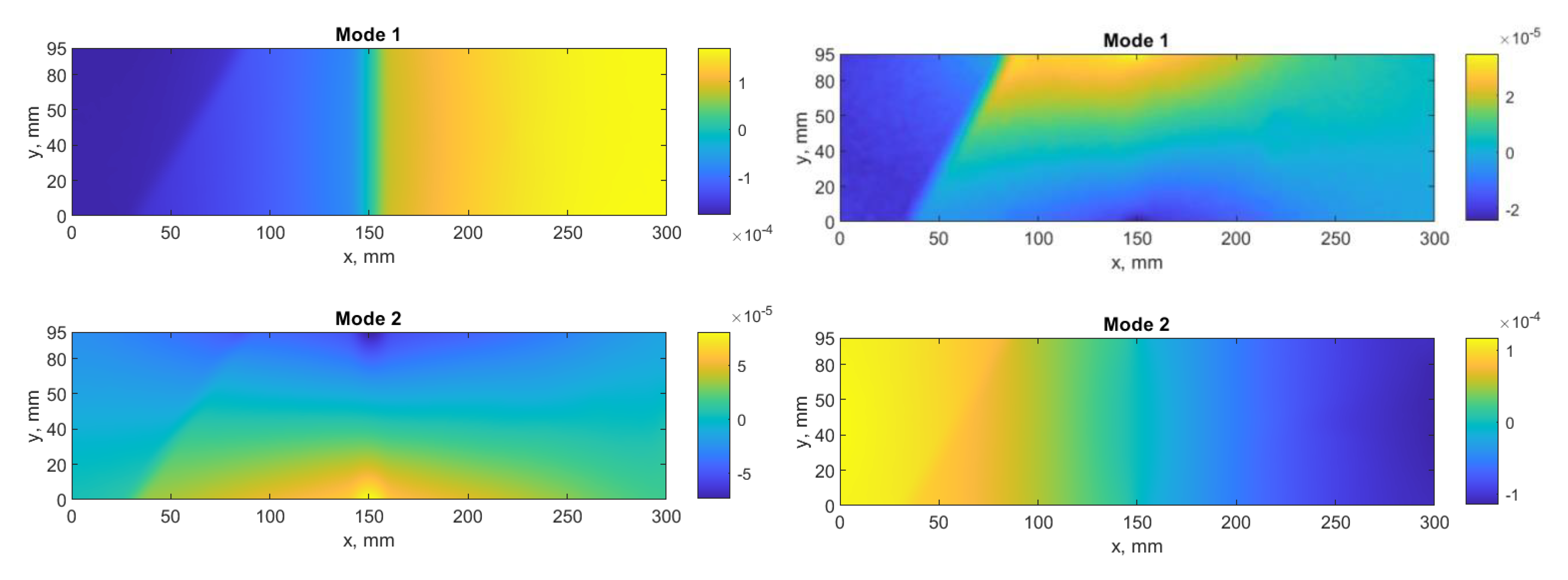


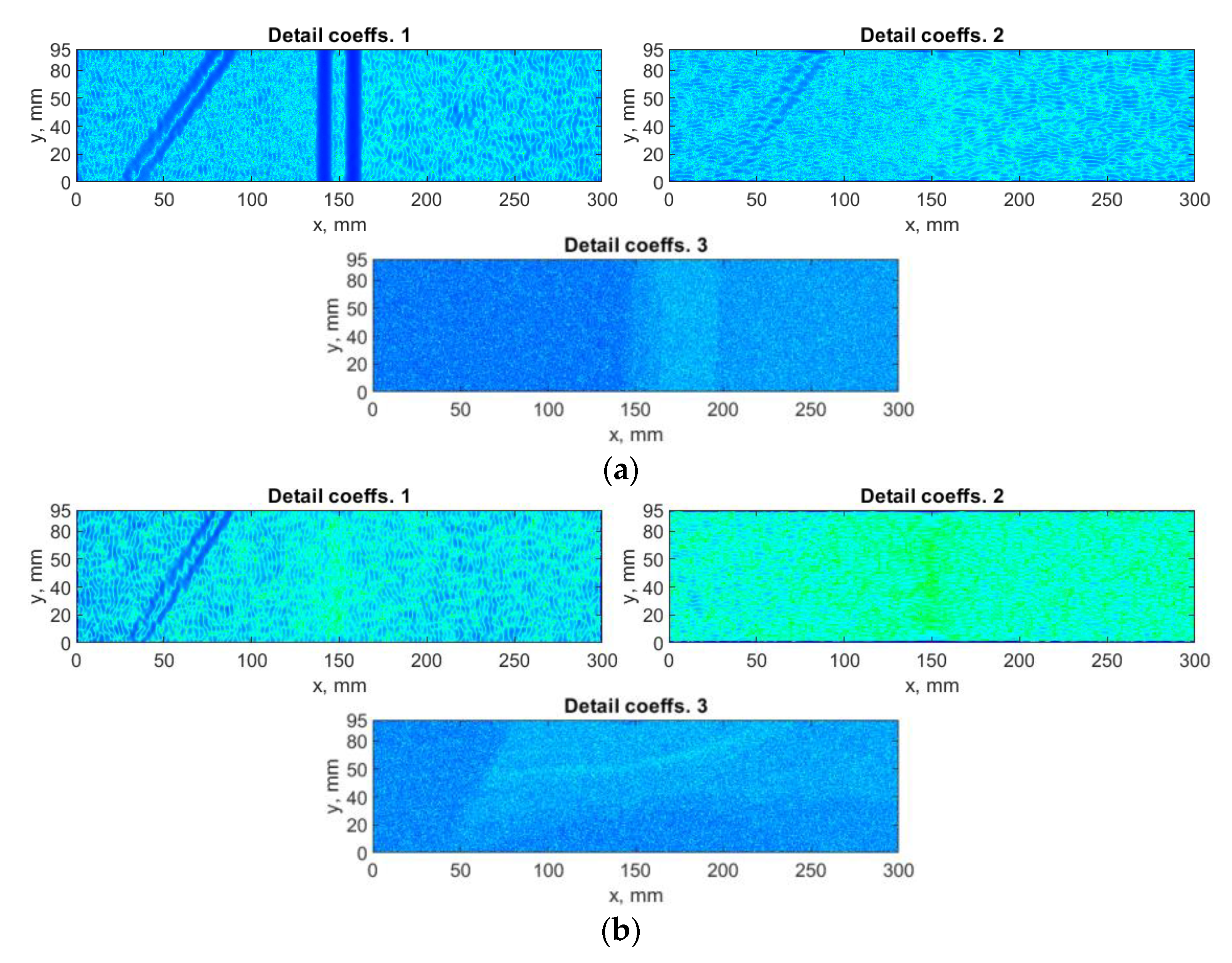

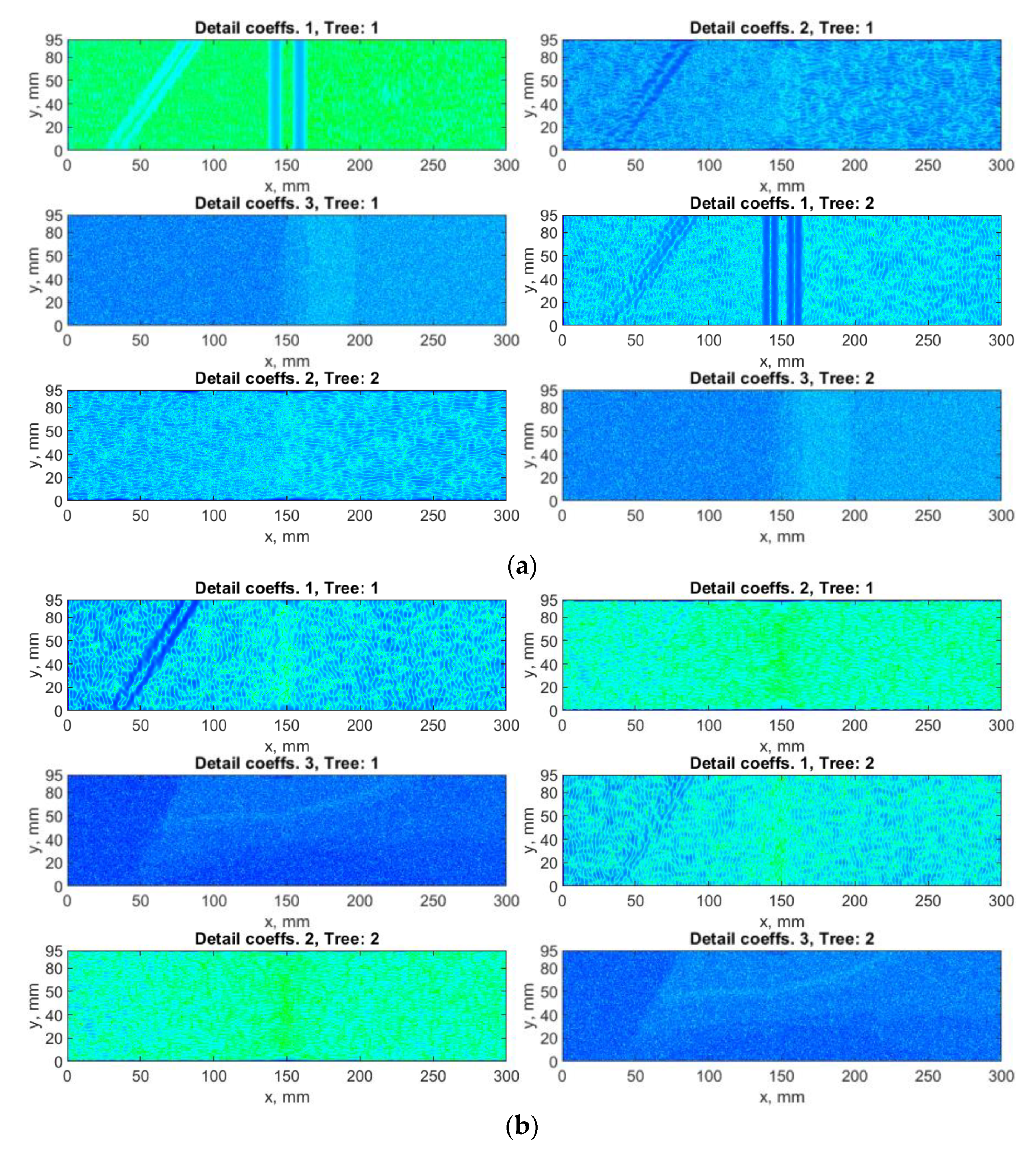


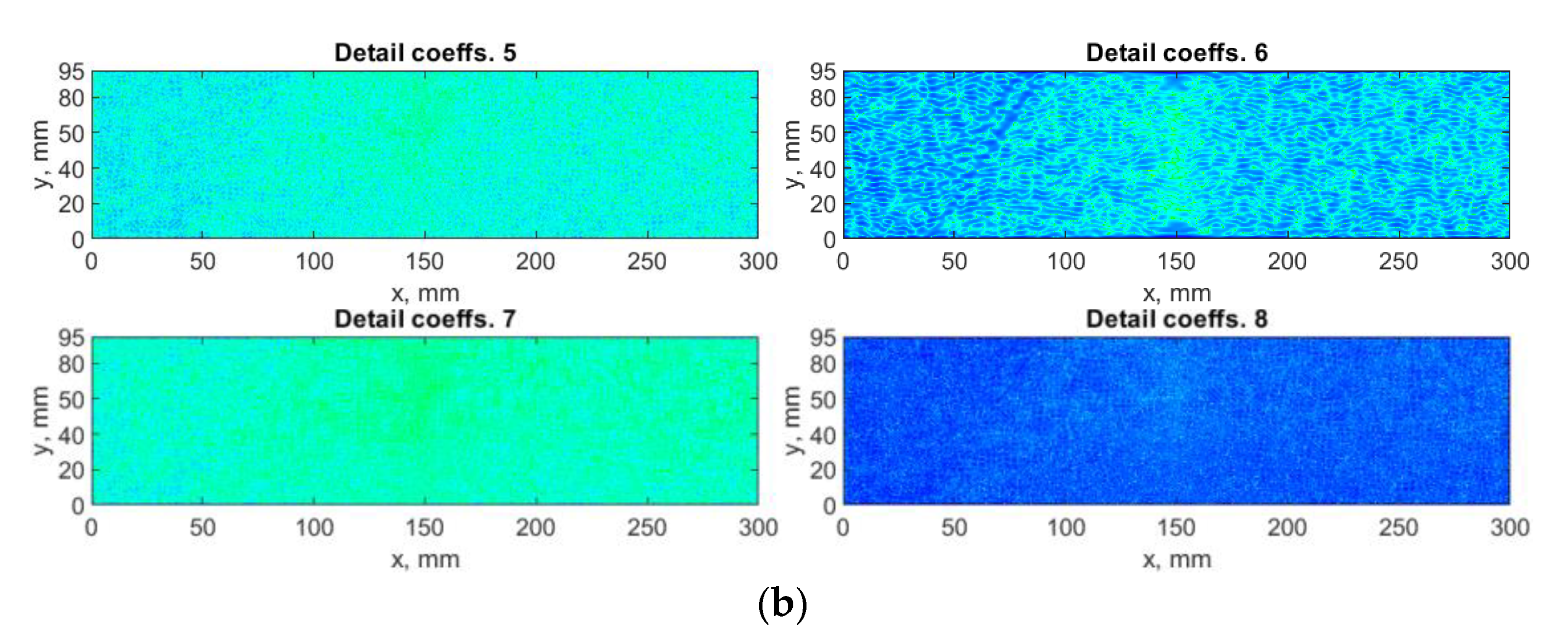

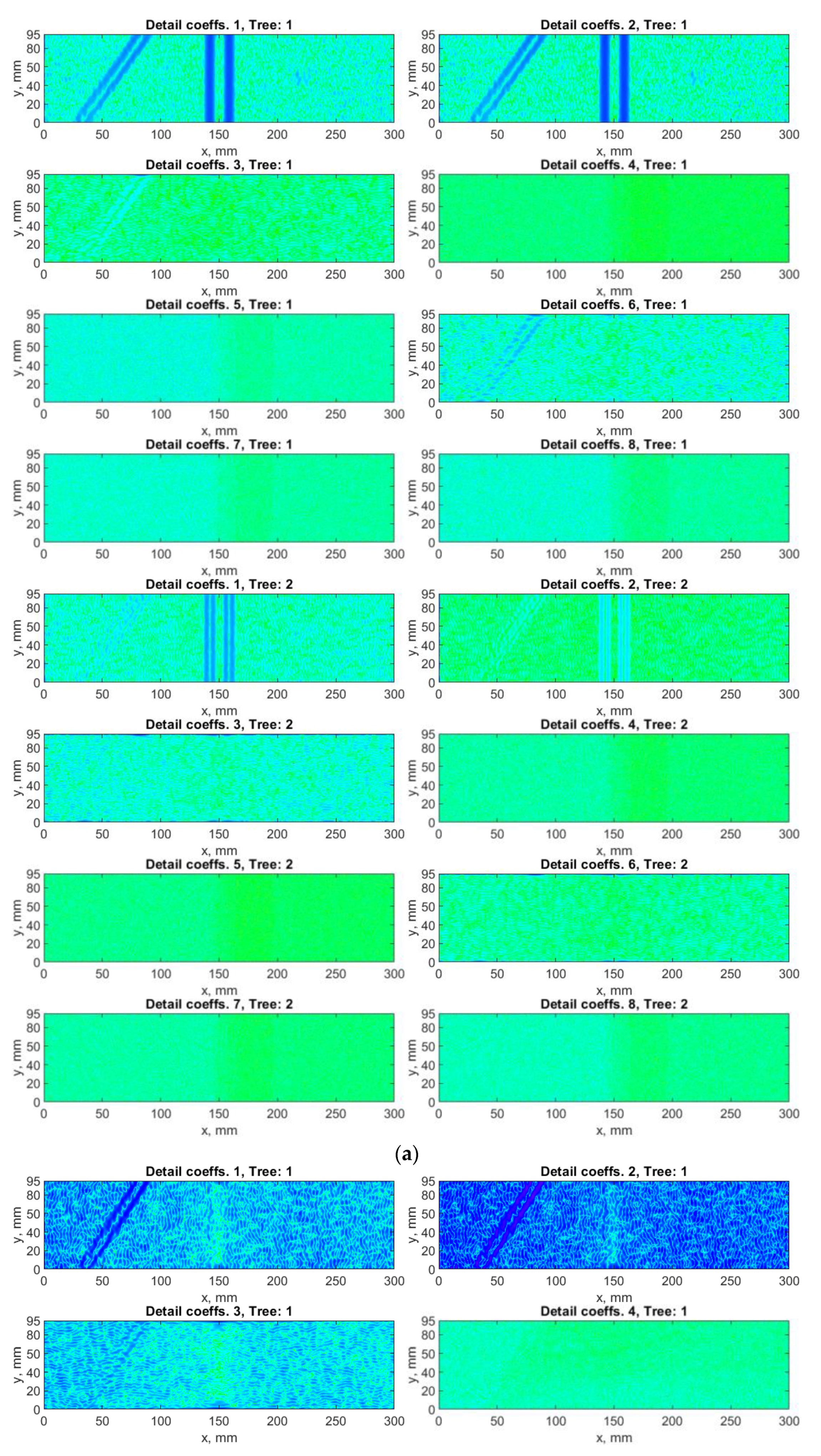
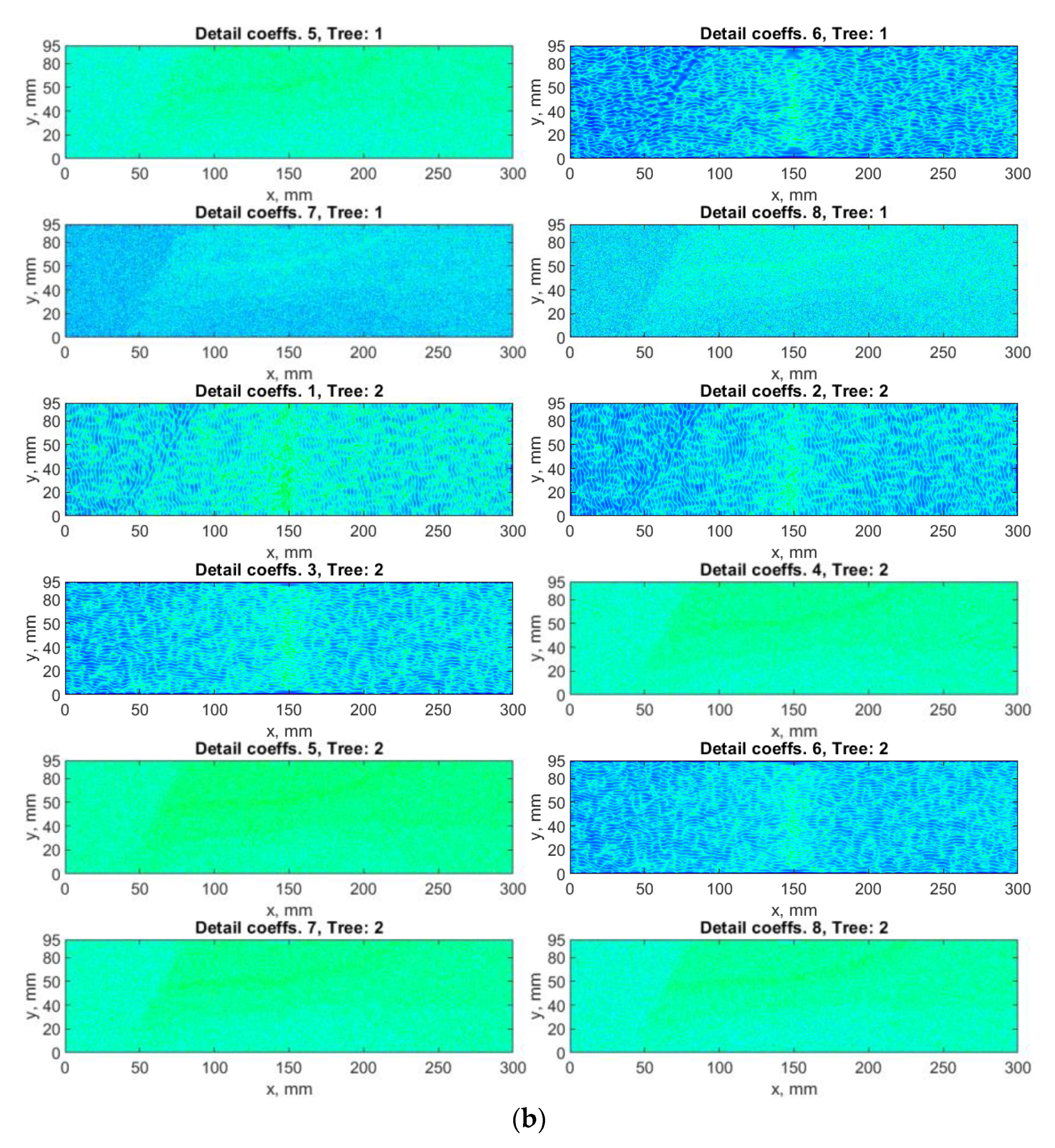

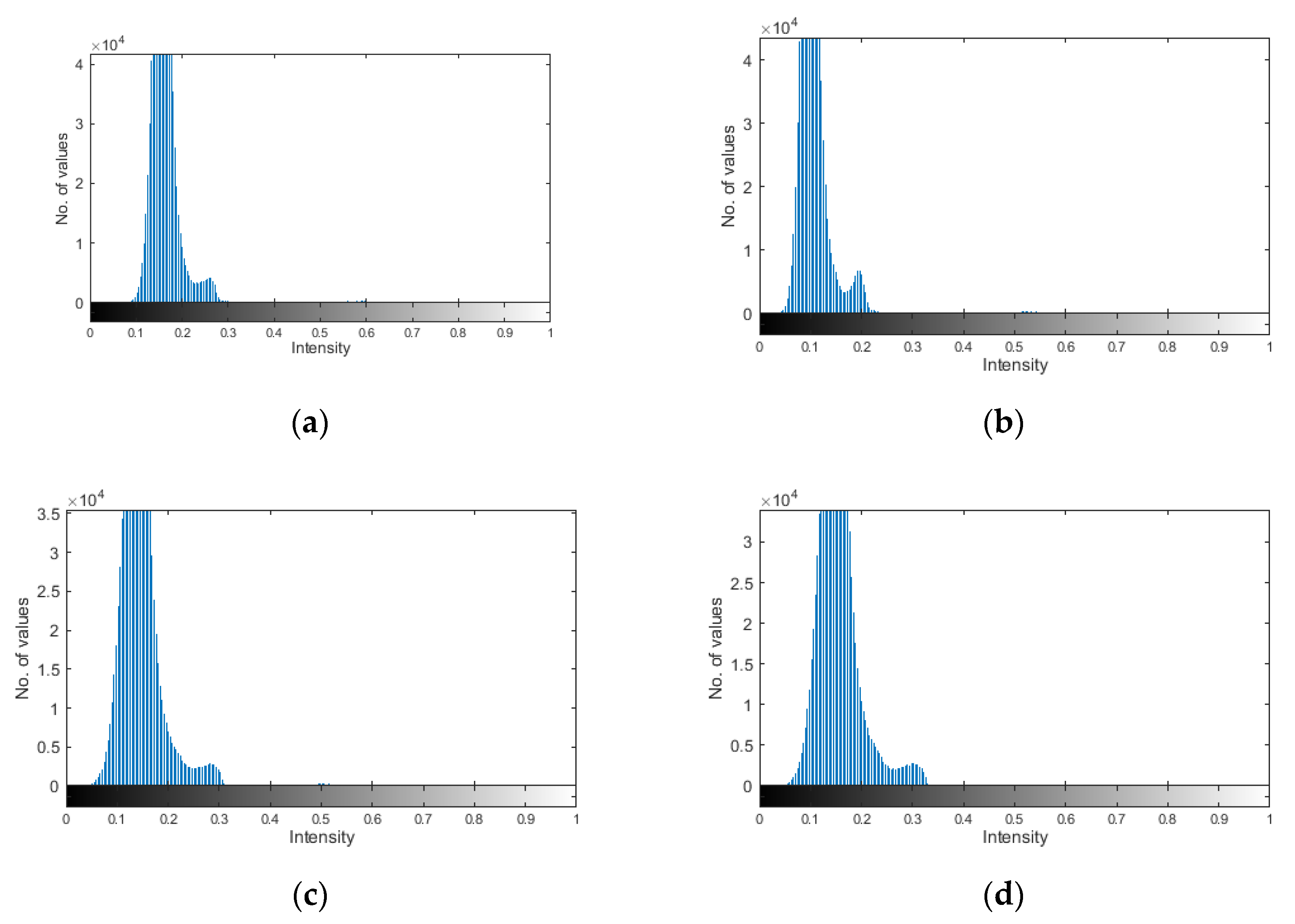
| Number | 1 | 2 | 3 | 4 | 5 | 6 | 7 | 8 | 9 | 10 |
|---|---|---|---|---|---|---|---|---|---|---|
| f, Hz | 73.8 | 137.1 | 252.1 | 303.1 | 441.4 | 506.0 | 776.5 | 850.4 | 951.1 | 1018.2 |
| Algorithm | DWT | DTWT | DDWT | DTDDWT |
|---|---|---|---|---|
| Threshold 1, – | 0.1882 | 0.1333 | 0.1725 | 0.1882 |
| Threshold 2, – | 0.4000 | 0.3804 | 0.3980 | 0.4078 |
| Intensity metric, – | 0.2074 | 0.2536 | 0.3169 | 0.3000 |
| Algorithm | DWT | DTWT | DDWT | DTDDWT |
|---|---|---|---|---|
| NIQE, – | 5.8497 | 6.0903 | 4.6318 | 4.6998 |
Publisher’s Note: MDPI stays neutral with regard to jurisdictional claims in published maps and institutional affiliations. |
© 2021 by the author. Licensee MDPI, Basel, Switzerland. This article is an open access article distributed under the terms and conditions of the Creative Commons Attribution (CC BY) license (http://creativecommons.org/licenses/by/4.0/).
Share and Cite
Katunin, A. Performance of Damage Identification Based on Directional Wavelet Transforms and Entopic Weights Using Experimental Shearographic Testing Results. Sensors 2021, 21, 714. https://doi.org/10.3390/s21030714
Katunin A. Performance of Damage Identification Based on Directional Wavelet Transforms and Entopic Weights Using Experimental Shearographic Testing Results. Sensors. 2021; 21(3):714. https://doi.org/10.3390/s21030714
Chicago/Turabian StyleKatunin, Andrzej. 2021. "Performance of Damage Identification Based on Directional Wavelet Transforms and Entopic Weights Using Experimental Shearographic Testing Results" Sensors 21, no. 3: 714. https://doi.org/10.3390/s21030714
APA StyleKatunin, A. (2021). Performance of Damage Identification Based on Directional Wavelet Transforms and Entopic Weights Using Experimental Shearographic Testing Results. Sensors, 21(3), 714. https://doi.org/10.3390/s21030714






